 |
 |
|
 |
Living snow fences help keep roads drift-free |
 |
 |
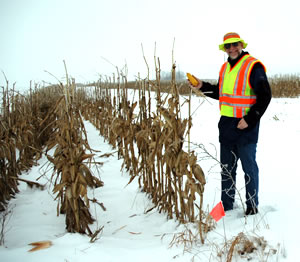 |
|
Before the Jan. 19 snowstorm: Bob Slater, District 6 forester, stands among the almost snowless corn rows on Dan Schmidt’s farm near Fountain. Photo by Craig Wilkins |
One overcast morning in mid-January, there wasn’t enough snow in Dan Schmidt’s fields to cover the opossum that trundled among his remaining rows of unpicked corn.
But a week later, the snow on the north side of his half-mile rows of corn plants fronting on Hwy 80 reached up to Schmidt’s chin.
Schmidt was pleased. Pleased that the living snow fence on his property functioned, and even more pleased that the tons of snow trapped by the corn rows occupied his fields instead of drifting onto Hwy 80, a few miles south of Fountain in Fillmore County.
Schmidt, who is also a U. S. Postal Service mail carrier, farms 320 acres of corn and soybeans. A highway clogged by drifts would hamper his ability to do both jobs.
Keeping drift-prone sections of state highways clear and safe underlies the Living Snow Fence program Mn/DOT operates.
The winter of 1996-97 prompted creation of the program. That winter brought heavy snowfalls statewide and high winds that clogged many roads, sometimes for days. The resulting expense and disruption of normal activity led the U. S. Department of Agriculture, Mn/DOT and other agencies to promote snow fences more aggressively as one way to limit heavy drifting on state highways.
This partnership involves farmers setting aside land to plant permanent snow fences using native grasses, shrubs and trees to create snow fences. That program, started in 2002, now has 20 landowners involved. Their fences help protect more than five miles of highways from drifting and blowing snow.
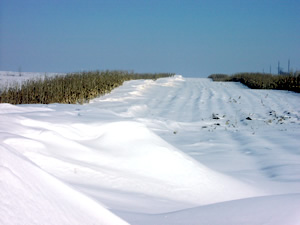 |
After the storm: Huge drifts collected on the northern section of Schmidt’s two corn plantings rather than on nearby Hwy 80. Photo by Bob Slater |
This winter, 44 landowners are enrolled in the corn row program, nearly a record number since the program began in 1997-98.
Participating landowners leave several rows of corn standing or plant two or three rows of grasses, shrubs or trees set back from the right of way to break the wind’s force, causing the snow to tumble in the air and collect around the plants.
Dan Gullickson, a forester with Environmental Services, is Mn/DOT’s living snow fence program coordinator. He worked with staff from counties, soil and water conservation districts and federal agencies to create the program.
Under its provisions, farmers and other participating landowners receive reimbursement of expenses for planting shrubs and trees for the living snow fences or leaving rows of corn unharvested until spring. Corn growers are paid $1.50 a bushel over fall market rates and can sell the crop in the spring.
The program returns $17 in savings for plowing, equipment rental, labor and other costs for every dollar invested, Gullickson said.
“This winter, we have standing corn rows sheltering about 20 miles of state highways in areas prone to heavy drifting,” he said.
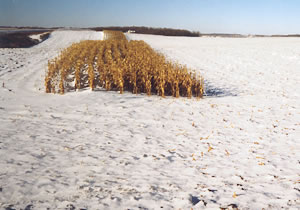 |
A snow fence stands ready to trap drifting snow on Hwy 34 near Dunvilla in Otter Tail County . Photo by Bill Hanson |
Central and southwestern Minnesota have the majority of snow fences.
“Well, it’s pretty breezy out here, so the program works well,” said Dean Olson, District 4’s maintenance superintendent at Morris.
This winter, Morris has a dozen participating landowners sheltering parts of Hwy 27, Hwy 28, Hwy 55 and other routes.
“The well-established fences work really well,” Olson said. “They hold a tremendous amount of snow.”
The Rochester District has nearly three miles of snow fence installations, including Schmidt’s.
Bob Slater, District 6 forester and snow fence coordinator, said the fences also reduce wind erosion and shelter wildlife.
“Mainly, though,” he said, “they reduce drifts and blowing snow and help keep roads open for school buses, emergency vehicles, other essential services, and maintain the area’s economic vitality.”
More information about both kinds of snow fences can be found at: www.livingsnowfence.dot.state.mn.us.
By Craig Wilkins
|
back

|
 |
Study estimates ridership will triple if bus rapid transit is used on I-35W corridor |
 |
 |
The Interstate 35W corridor is an excellent candidate to implement a bus rapid transit system, according to a report Mn/DOT issued Jan. 21. The I-35W BRT route would span about 20 miles between downtown Minneapolis and Lakeville.
"The I-35W corridor between Lakeville and Minneapolis serves a vital and growing area within and south of the Metro," Lt. Gov./Commissioner Carol Molnau said in a news release issued by the Governor’s Office Jan. 21.
"Current and projected travel demand throughout the corridor is staggering. For I-35W, BRT can provide a viable, attractive and affordable transportation choice for thousands of commuters, thus helping to reduce projected congestion growth,” she said.
The study, which was mandated by the 2003 Legislature, concludes that BRT service could significantly increase transit capacity in the I-35W corridor. Current transit service carries 15,000 express bus riders each weekday in the corridor, the most heavily used transit corridor in the region. According to the study, BRT service would increase ridership to 43,000 riders per day by 2030.
For more information, see:
|
back

|
 |
Phone call, sprinklers avert major damage from District 1 headquarters fire |
 |
 |
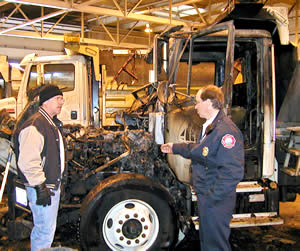 |
|
Duluth District Engineer Mike Robinson, at left, discusses the fire at the Duluth headquarters with Richard Mattson, Duluth’s assistant fire chief. Photo by John Bray |
Thanks to an alert passerby and a fire containment system, damage from a blaze at the Duluth/District 1 headquarters was limited to the loss of one snowplow truck and minor smoke damage.
The fire occurred Jan. 29, a Saturday, about 1 p.m. when a snowplow owned by the city of Duluth based at the headquarters facility caught fire. Duluth firefighters extinguished the fire which caused an estimated $90,000 in damage, including the loss of the $70,000 snowplow.
The passerby saw smoke billowing from the building and called 9-1-1, which dispatched city firefighters. District Engineer Mike Robinson and John Bray, special assistant to the district engineer, were notified and went to the scene.
Bray said the fire was out but still smoldering when he and Robinson arrived.
Other district staff responded to the situation as well. Bill Haug, district safety officer, checked in to determine the extent of damage. Fred Johansen and Don Silverness, the district’s electrician and plumber, respectively, also reported in to ensure the building’s operating systems were intact.
The city of Duluth stations snowplows, motor graders and other equipment used in downtown Duluth at the district facility it shares through a partnership agreement.
Fire officials, Bray said, suspect an engine wiring mishap as the fire’s origin, but the exact cause is still under investigation by the Duluth fire marshal.
“The sprinkler system really saved us,” Bray said. “It was a Saturday and there wasn’t anyone in the city’s section of the building.”
|
back

|
 |
Governor proposes 2006–07 biennial budget |
 |
 |
Gov. Tim Pawlenty last week unveiled his proposed FY 2006-07 biennial budget, one he said that responds to Minnesota’s fiscal challenge and builds on the positive changes state government has made in the last two years.
The budget Pawlenty presented eliminates a projected budget shortfall of $700 million for the two-year state budget that begins July 1, 2005. Proposed general fund spending for the FY 2006-07 budget is $29.667 billion, a $1.6 billion (5.8 percent) increase over the current budget.
For transportation, the governor recommends a biennial budget of just over $4.8 billion, of which $4.2 billion would go to programs that include the design, construction, maintenance and management of state highways and bridges; financing of county and municipal state aid roads; funding for Twin Cities and Greater Minnesota transit operations; the development and maintenance of airports, freight and commercial vehicle operations, traffic safety, and the State Patrol.
“It’s important to understand that the transportation budget supports not only Mn/DOT, but also local governments and the transportation-related needs of other agencies,” said Kevin Gray, Finance and Administration Division director.
“Also worth noting is that the state’s General Fund supports only 3.7 percent of the funding for activities in the transportation budget,” he said. “The lion’s share of transportation funding is in the Trunk Highway Fund in the form of federal and state funds derived from fuel tax revenues and vehicle registration fees.”
Gray said Mn/DOT’s budget is grouped into four core programs: State Roads; Multimodal Systems; Local Roads, and General Support and Buildings.
State Roads—Infrastructure Investment and Planning Program
The budget for Mn/DOT includes $1.8 billion for the design and construction of major capital projects—the reconstruction of aged highways and the construction of new roads, bridges, interchanges and other transportation infrastructure.
State Roads—Infrastructure Operations and Maintenance Program
The budget for Mn/DOT includes $422 million to maintain and operate the state’s road system. This program also includes the maintenance and operation of the state rest area system. The 2004-05 budget allocation for operations and maintenance includes a $17 million shift from construction to maintenance. According to Gray, the shift is a step towards addressing increasing needs to maintain and preserve state highways and bridges, and enhance traffic systems to help manage congestion.
State Roads—Electronic Communications Program
This program is dedicated to maintaining and improving wireless communications for Mn/DOT and public safety agencies across the state. A key objective is to fulfill Mn/DOT’s commitment to ensure a functioning communications system, and ultimately, to support a statewide 800 Mhz communications systems.
Multimodal Systems Program
This program includes airport improvements, transit, freight services, and related education and safety efforts. Mn/DOT approves grants for 136 public airports in the state aviation system plan, supports public transit services in 65 counties in Greater Minnesota, issues 100,000 permits and credentials for intra- and interstate motor carriers, and supports rail and port programs.
Local Roads Program
Mn/DOT administers local road funds that go to all 87 counties and 133 municipal state-aid cities in Minnesota. The budget proposal requests more than $1.17 billion for county state aid funds and another $243 million for cities for the next biennium.
General Support and Buildings Program
This program provides leadership and specialized support services for the department’s financial, human and capital resources (including buildings).
Gray said that Mn/DOT’s budget remains program-delivery focused and aggressively uses available resources, including projected federal funding (the level of which is still dependent on the outcome of reauthorization).
For information on the governor’s budget proposal, visit the Department of Finance at http://www.finance.state.mn.us/
Looking beyond 2006-07, the Pawlenty/Molnau administration recently unveiled a transportation funding package that could provide $7.15 billion during the next 10 years through permanent increases in transportation funding (requiring a constitutional amendment dedicating 100 percent of Motor Vehicle Sales Tax revenue to transportation) and a $4.5 billion bonding program to accelerate major highway projects. This funding package will have a significant department-wide impact and become part of Mn/DOT’s 2008-09 budget, Gray said.
For information on the transportation financing package, go to http://www.dot.state.mn.us/financing/2005/index.html.
By Jeanne Aamodt
|
back

|
 |
Snowplow ride-alongs take news reporters where the action is |
 |
 |
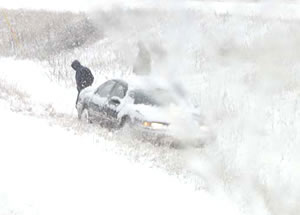 |
|
This car narrowly missed colliding with the plow driven by Jill Grindle before sliding into the ditch along Hwy 55 near Annandale . Photo by Brenda Dockendorf |
News reporters who have recently shared the jarring and sometimes daunting ride-alongs with Mn/DOT plow operators tell a vivid story about the rigors and rewards of their service to the public.
District officials invite reporters to ride with drivers to help them gain a realistic, first-person perspective on the many facets of snowplowing operations. That way, reporters can share the challenge of keeping roads safe with their audiences as well as convey the sense of pride and responsibility that Mn/DOT maintenance employees have about their jobs.
Here are recent examples of reports done after ride-alongs with Mn/DOT snowplow operators.
From the Annandale Advocate
Pulling onto Hwy 55 on a snowy Jan. 19, District 3 snowplow operator Jill Grindle, Buffalo Truck Station, told reporter Brenda Dockendorf, “This is what we live for.”
Dockendorf chronicled each of Grindle’s well-rehearsed moves as the snowplow headed for the highway to plow between Kimball and Buffalo.
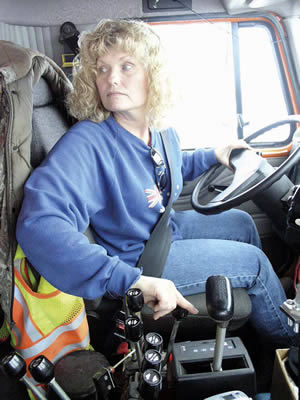 |
Jill Grindle, Buffalo Truck Station, backs her snowplow near Annandale before plowing Hwy 55. Photo by Brenda Dockendorf |
“The 25-ton truck shuddered as it lumbered out of Annandale to the open highway and slowly built up speed. Grindle flicked on her windshield wipers as the snow continued to fall, then grasped one of nine levers at her elbow.
“The wing blade dropped and spray of dirty snow shot out over the ditch. She kept on the gas until the speedometer reached 30 mph.
“'We try to stay between 30 and 45 miles an hour,’ she said. ‘In a heavy snow like this, we don’t like to go much faster than 30 mph.’
“Traffic in the oncoming lane inched by a few feet below her window. Just past South Haven, an approaching car went out of control and swooped into the ditch before her eyes.
“'That hardly even happens,’ Grindle said calmly. ‘Usually they’re already in the ditch when I come through.’”
According to Cathy Clark, District 3 public affairs coordinator, the ride-alongs give reporters an inside look at department operations and help reveal its more human side.
“Reporters get to know some of our high-caliber employees and to see the excellent work they do, often under adverse conditions,” Clark said.
From KSTP-TV, Twin Cities
In the Twin Cities metro area, Kent Barnard, a Metro District information officer and part-time snowplow operator, took KSTP reporter Leah McClain on his plow route on Interstate 35W, Hwy 10 and Hwy 51 in St. Paul’s northern suburbs.
“By riding with us, reporters can see what we see and what we’re often not able to see,” Barnard said. “They also see, unfortunately, a lot of dangerous driving by motorists, but that does help clarify the need for our safety messages.”
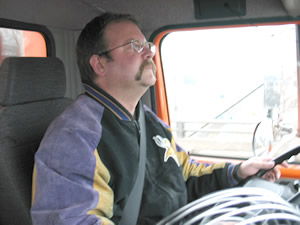 |
Kent Barnard, a Metro District public affairs coordinator and part-time plow operator, took a reporter and photographer from KSTP-TV on his route in the St. Paul suburbs. Photo by Kevin Walker |
From the Mankato Free Press
Bryan Lillie took Carol Seavey, a Mankato Free Press reporter, with him on Jan. 22 as he and three other operators from the Mankato Truck Station plowed Hwy 169 between Mankato and St. Peter.
Seavey observed Lillie’s easygoing confidence as he orchestrated a series of levers to control the front, wing and underbody plows while he maneuvered around guardrails and street signs. She also wrote about the risks careless drives create.
“When Lillie sees someone drive up on his left side with intentions to pass, he’ll move into their lane a bit to discourage them. They usually fall back, but sometimes they don’t. Last year, one truck was hit by a vehicle three times.
“Mn/DOT’s “Stay Back. Stay Alive” campaign has reduced such incidents, but Lillie still expects a few accidents and to be flicked off a few times.”
From the Fargo Forum
At Moorhead, Fargo Forum reporter Gerry Gilmour rode with Gary Groslie from the Moorhead Truck Station as he plowed Hwy 10 between Moorhead and Alexandria.
Groslie was spreading sand and salt and brine and hoping the relatively warm temperature would hold long enough to the melt ice forming in the wheel tracks before temperatures started to drop sharply.
Gilmour described the truck’s high-tech interior, including instruments that inform Groslie about air and surface temperatures.
Groslie monitors the weather and keeps in touch with other drivers and state troopers over another radio. Periodically, he‘s asked to call in a road report to Morris, so current road information can be broadcast on state radio.
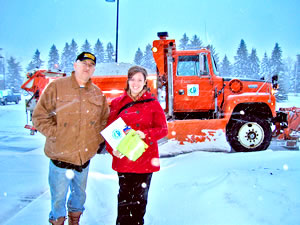 |
Sarah Fleener, a Duluth Budgeteerreporter, meets with District 1’s Joe Ninefeldt before joining him for a plow ride-along in Duluth. Photo by John Bray |
From the Duluth Budgeteer
In Duluth, plow operator Joe Ninefeldt cranked up his classical music station, readied his intercom and welcomed Duluth Budgeteer reporter Sarah Fleener aboard his plow.
Fleener rode with Ninefeldt as he teamed with two other drivers on their route through Duluth and shared stories and insights from his 35 years of snowplowing.
He recalled major storms from the past and expressed his respect for the city of Duluth snowplow operators and their ability to deal with traffic, parked cars, narrow streets and steep hills.
As he neared the end of his shift, Ninefeldt also told Fleener about the satisfaction the work brings.
“I like this job because when I look out the mirror, I can see all the work I’ve done,” he said. “We plow it, clear it and lay down the chemical. Every shift is an accomplishment.”
Speaking from her office at the weekly newspaper, Fleener said her ride with Ninefeldt was upbeat and informative.
“It was an unique experience for me,” she said. “Joe was so funny and so open that the experience was an enlightening one for me and our readers.”
By Craig Wilkins
Plow rescue run in near white-out earns grateful thanks from Springfield EMT
Sometimes recognition comes via a simple, hand-written note.
The note was from an emergency medical technician in Springfield after the city’s ambulance crew received a snowplow escort in the midst of a storm from four Mankato/District 7 employees.
“Due to the weather and road conditions, the patient could not have received the medical care she needed without your help. A special thank-you to the plow operators from the Sleepy Eye and New Ulm truck stations for plowing the way for us in the near-zero visibility. You did a wonderful job for us!"
District employees who cleared the way for ambulance are Rich DeSaer and Ron Meyer, Sleepy Eye Truck Station, and Larry Holm and Jerry Schultz from the New Ulm Truck Station.
The note was from Brian Fuhrmann, an EMT with the Springfield Ambulance Service.
|
|
back

|
 |
Drained lock provides a close-up look at shipping on the Mississippi |
 |
 |
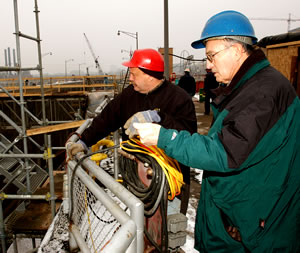 |
|
Dick Lambert, Waterways Section director (at right), views rehabilitation efforts under way at the Upper St. Anthony Lock and Dam on the Mississippi River in Minneapolis with Dennis Creen, a transportation program specialist with the Office of Freight and Commercial Vehicle Operations. They joined other FCVO staff to visit the lock which was drained of water to allow painting, repairs and other lock maintenance work. Photo by David Gonzalez |
Officials from the U.S. Army Corps of Engineers and Mn/DOT got down to the very bottom of the Upper St. Anthony Lock and Dam in Minneapolis on Feb. 2.
It was easy. The cavernous lock has been drained since January to allow inspection, repairs and repainting of the northernmost lock and dam on the Mississippi River.
It was the first time in 25 years that the lock was completely drained.
Dick Lambert, Waterways Section director, said dewatering enables officials to view the lock’s complex filling and draining system and to determine repairs or upgrades as they plan for future commercial river traffic on the upper end of the Mississippi River.
The upper and lower St. Anthony locks and dams are the northernmost ones on the river. They were constructed in the 1950s and ‘60s to enable river barges to bypass St. Anthony Falls and establish a port in north Minneapolis.
A total of 29 locks and dams step the river down about 400 feet between Minneapolis to St. Louis on what is designated as the Upper Mississippi River.
Lambert said the port handles up to1.5 millions tons of commodities each year including grain, gravel, coal, steel, cement and rock salt.
Plans by the city of Minneapolis to convert part of its port for parkland, housing and other uses, Lambert said, will have an effect on river shipping and other transportation modes as well.
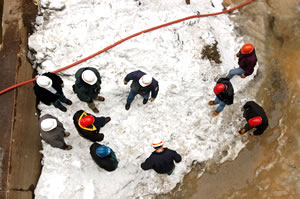 |
A surface-level view of the lock indicates its depth and size. The lock was last drained for maintenance in 1979. Photo by David Gonzalez |
He said, for example, that grain that was once delivered to the Minneapolis port by rail now goes to the port at Savage on the Minnesota River for shipment downriver on the Mississippi.
“The concern that we have, of course, is additional truck traffic on our already congested Twin Cities metro area highway system,” he said.
Lambert said, however, that shipping by river offers many advantages as it has since the lock and dam system was completed on the Upper Mississippi River in the 1930s.
Shipping by river barge, Lambert said, moves about 14 million tons of freight in and out of Minnesota each year, the equivalent of 140,000 rail cars or 560,000 truck loads.
“River shipping,” he said, “is still the cheapest way to ship commodities.”
By Craig Wilkins
|
back

|
 |
Alerts notify state employees of unhealthy air quality |
 |
 |
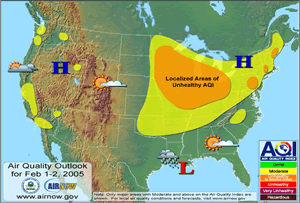 |
|
This map indicates the areas in the United States, including all of Minnesota, where the worse air quality was registered Feb. 1-2 due to a stagnant air mass. Source: Environmental Protection Agency |
Mn/DOT employees statewide received e-mail messages this week notifying them that the air quality in Minnesota was considered unhealthy and that prolonged strenuous activity outdoors should be avoided.
In the past, information like this was distributed solely through the news media.
But since the Governor’s Clean Air Minnesota Executive Order 04-08 last summer, state agencies now also bear responsibility for notifying their employees when outdoor air quality is poor, said Larry Thompson, Mn/DOT’s safety director.
The Minnesota Pollution Control Agency issued the first air pollution alert on Monday when the Air Quality Index in the Twin Cities hit 137. At that time, the reading in Rochester was 120 and in Duluth, 86. An AQI value from 0 to 50 is considered “good,” 51 to 100 is “moderate,” 101-150 is “unhealthy for sensitive groups,” 151-200 is “unhealthy,” and 201-300 is “very unhealthy.”
“Sensitive groups” include the elderly, the very young and people with heart and respiratory diseases.
Thompson distributed the MPCA alert to employees via GroupWise. He sent an updated alert on Tuesday, which was expected to be in effect through Feb. 2, and involve approximately the southern three-fourths of Minnesota and the city of Duluth. On Tuesday, the AQI in the Twin Cities reached 156.
The U.S. Environmental Protection Agency developed the AQI to measure four air pollutants: ozone, sulfur dioxide, fine particulate matter and carbon monoxide. The AQI rises when fine particles, or soot, are trapped near the ground by stagnant air, such as the weather pattern experienced in Minnesota and other Great Lakes states this week.
The governor’s Clean Air Minnesota order directs all state agencies to:
Inform employees when the MPCA issues air pollution alerts. Thompson is the department’s primary contact. Marilyn Jordahl-Larson, Environmental Modeling & Testing Unit chief, is Mn/DOT’s alternate contact.
-
Implement air pollution reduction strategies, including purchasing or leasing the most fuel-efficient and least polluting vehicles that meet the operational needs of the department; encouraging employees to consider alternatives to single-occupancy vehicle commuting, and using energy-conserving strategies in state-owned or leased buildings.
Ways individuals can help reduce air pollution, especially during a high alert time, include:
-
Reducing driving when possible and not idling vehicle engines
-
Postponing activities with small gasoline or diesel engines
-
Postponing fires in the fireplace and outdoors
“Mn/DOT already has taken a number of steps to reduce air pollution as an agency,” Thompson said, “including using more fuel-efficient vehicles in our fleet and encouraging employees to carpool and use other alternatives to driving alone to work.”
For more information, see:
|
back

|
 |
District 6 appoints Kristine Hernandez to public affairs post |
 |
 |
 |
|
Kristine Hernandez Photo by Brian Jergenson |
Kristine Hernandez, formerly a public affairs official with the American Cancer Society, was appointed as the public affairs coordinator with Rochester/District 6.
She succeeds Brian Jergenson who resigned.
Hernandez served as the cancer society’s director for constituent relations in Minnesota. Her experience includes more than 15 years of marketing and communications work in southern Minnesota communities such as Austin, Albert Lea and Rochester.
An Albert Lea native, Hernandez holds a bachelor’s degree in mass communications from St. Cloud State University and a master’s degree in business administration from Winona State University. She is a member of the Public Relations Society of America.
In her new position, Hernandez directs the district’s public affairs and communications functions.
She may be reached at 507/285-7364.
|
back

|
 |
MnROAD tests pavement sections containing taconite aggregate |
 |
 |
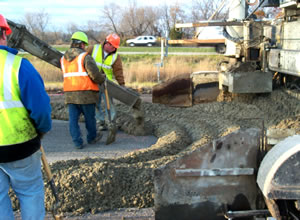 |
|
A concrete/taconite pavement test section constructed at the MnROAD facility on Interstate 94 near Monticello last October won an environmental award for the use of a taconite aggregate in a concrete test section. |
“News flash! New pavement product wears like iron!”
You could see this headline in Minnesota news papers in the future after the Minnesota Road Research program completes testing two new pavement sections constructed last year using taconite aggregates.
“Taconite materials from Minnesota’s Iron Range have great potential as aggregate source for Minnesota’s highways,” said Ben Worel, MnROAD operations engineer. “The taconite aggregate used in the MnROAD test sections is very hard and durable with low absorption qualities, which is desirable for use in roadways.”
Taconite aggregates come in two forms: taconite rock (used in the MnROAD project) and taconite tailings. Both are mining byproducts from the Mesabi Iron Range west of a line near Biwabik, Minn. Materials from ore mined east of this line contain ingredients that resemble asbestos and can’t be used.
Mn/DOT, in corporation with the Department of Natural Resources, partnered with Twin Cities area industries to mine, crush, truck, mix and construct the two test sections at MnROAD.
“Taconite aggregates have been used in many projects in Northeast Minnesota, but not in other areas due to high shipping costs,” Worel said. “But now, with looming aggregate shortages in the future, this could be an excellent alternative.”
Large quantities of taconite rock are stockpiled on the Iron Range, which makes its use as roadway aggregate a “greener” option than other concrete and bituminous aggregates.
In fact, MnROAD won a first place General Environmental Initiative award from the Aggregate & Ready Mix Association of Minnesota for its use of taconite rock in the concrete test section.
MnROAD will test and monitor the taconite/concrete test section, and a taconite/bituminous section during the next five to-10 years to demonstrate their long-term performance and benefits. If the test goes well, MnROAD will consider using taconite aggregates in other test sections to be constructed in 2006.
“This is a unique opportunity for MnROAD,” Worel said. “If research results are successful and the transportation issues are solved, taconite materials could become a new aggregate source in Minnesota and other states.”
|
back

|
 |
New Hwy 100 bridge earns award for construction excellence |
 |
 |
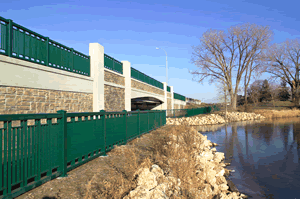 |
|
Simulated stone facings and ornamental railings improve the appearance of the new Hwy 100 bridge over Twin Lakes in Robbinsdale. Photo by Dave Raley
|
Construction of a new Hwy 100 bridge in Robbinsdale earned honors for a Metro District bridge construction team and the project contractor during the Associated General Contractors of Minnesota annual meeting in St. Paul.
The Mn/DOT-AGC bridge award was presented Jan. 20 by Dick Stehr, Technical Services Division director.
Award criteria include workmanship and appearance, innovations used by the contractor, complexity of the project and timely delivery.
Contractor for the project was the Lunda Construction Co.
The award presentation cited the team’s ability to construct the bridge on time while maintaining vehicular traffic on the bridge as well as keeping the channel in the Twin Lakes area open for boaters.
Other accomplishments noted include use of erosion control measures to minimize pollution, esthetic treatments such as simulated stone facings and ornamental railings and the structure’s connection with recreational trails in the area.
Dave Raley, senior engineering specialist, Golden Valley Resident Office, served as the project supervisor. Barry Nelson and Joe Krueger served as project inspectors.
Other projects nominated for the award include the Hwy 43 bridge over Rush Creek in Rushford and the France Avenue bridge over Hwy 100 in Brooklyn Center.
“Several award programs exist to recognize bridge designers,” Stehr said, “but this award is intended to recognize excellence by the construction team, the AGC contractor and district construction staff who together complete construction of trunk highway bridges for Minnesota.”
By Craig Wilkins
|
back

|
 |
New timesheet editing feature helps prevent coding errors |
 |
 |
Entering an activity code on your timesheet that is not in sync with an appropriation code will now prevent you from completing your time sheet.
As of Jan. 31, the Activity-Based Budgeting staff and Accounting System group have implemented a new feature in the Resource Consumption Application that detects errors in timesheets that will have to be corrected before the timesheets can be processed for payment.
“Employees will see a notice of this new editing feature when they log into RCA to do their timesheet,” said Larry Moser, ABB/Costing manager in Finance and Administration. “The feature will prompt employees to validate entries before the end of the pay period to correct any errors.”
Moser said the change is important because the codes employees put on their timesheet not only help Mn/DOT to determine where they add the most value to the organization, but codes can affect future budgets, too.
“In addition, coding must comply with appropriation law,” Moser said. “Up to now, we have identified and corrected errors on a monthly basis. It’s important that all employees use codes that reflect the real work that they do and the appropriate funding.”
This is how the new RCA feature works:
New edits will prevent you from marking your timesheet complete until mismatches between funding and activity codes are corrected.
To avoid last-minute problems, click on the “Validate Entries” button at the top of your time sheet at least a few days before the end of the pay period and correct any errors.
If you receive an error notice indicating your activity codes or appropriation number are incorrect, go to the Financial Web Reporting page to find numbers that correspond to your work area and activities.
Once you make corrections to your time sheet and validate your entries, you can mark the time sheet complete.
|
back

|
 |
Agencies use mall forum to educate public on reducing road fatalities |
 |
 |
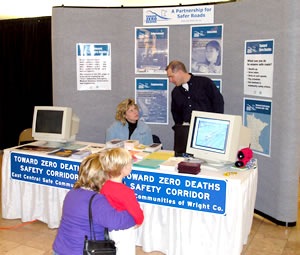 |
|
Two shoppers watch a computer presentation while Pat Huckman, executive director, Safe Communities of Wright County, and Todd Kramascz, Mn/DOT’s Regional Transportation Management Center, staff the Towards Zero Deaths exhibit at the Mall of America in Bloomington. Photo by Kevin Gutknecht |
Shoppers at the Mall of America Jan. 29-30 found a life-saving bargain, thanks to the Toward Zero Deaths program exhibit.
Mall walkers stopped by the TZD exhibit to learn more about reducing and eliminating road fatalities. The exhibit was part of an annual Government on Display Expo that Mall of America sponsors.
TZD is an inter-agency partnership that includes Mn/DOT, the Department of Public Safety, the Federal Highway Administration, Minnesota county engineers and the Center for Transportation Studies at the University of Minnesota.
The TZD exhibit included a Minnesota State Highway Patrol car, a Mn/DOT Freeway Incident Response Safety Team truck, and a booth overflowing with information regarding highway safety.
Mn/DOT representatives at the booth over the two days included Bill Boran, Tony Fischer, Brian Kary, Todd Kramascz, John McClellan, Mary Meinert and Joe Zabilla.
By Kevin Gutknecht
|
back

|
 |
|
 |



